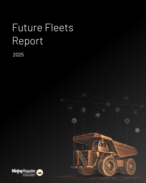For the December quarter, Peabody’s net income fell to $US92.2 million from $293.1 million in the same period last year. Revenues were also on the decline, coming in at $1.55 billion versus $1.89 billion, and sales fell 18% to $1.55 billion.
For the year, 2009’s second half helped brighten the bottom line. Income from continuing operations totaled $457.9 million, and revenue was $6.01 billion based on sales of 243.6 million tons.
While the market has left sales shaky for operators, including Peabody, the company was happy with the 2009 result.
"The strength of Peabody's global platform and strategies allowed us to deliver the second-best year in our history in the face of a severe recession," Peabody chief executive Gregory Boyce said.
"Our near-term focus remains serving the high-growth Pacific markets as we expand our Australian volumes and global trading activities."
Tonnage was down overall – from 255Mt to 243.6Mt year-on-year – reflecting Powder River Basin reductions that were offset in part by production from the new El Segundo mine and higher volumes from Peabody’s Midwestern properties.
However, Australian numbers were on the up, with total volumes of 22.3 million tonnes, including 6.9Mt of metallurgical output and 9.6Mt of seaborne thermal shipments.
Peabody attributed the 37% volume increase to growing customer demand.
In the US, Peabody pointed to its long-term strategy of securing multi-year contracts at favorable prices, thereby securing its baseload business.
“In 2009, we responded to rapidly changing demand by exercising tight capital discipline and aggressively targeting operating costs," Peabody executive vice-president and chief financial officer Michael Crews said.
In 2010 the company expects an 8% jump in seaborne Pacific coal markets.
“Prices for seaborne met and thermal coals are moving higher as China and India are rapidly increasing imports and traditional Asian-based customers are returning to pre-recession growth levels,” Peabody said.
“Australia, the world's largest coal exporter, increased 2009 shipments 6 per cent to a record 277 million tonnes. Australian shipments continue to increase to satisfy rising Asian demand, with exports to China reaching 45 million tonnes compared with only 4 million tonnes in the prior year.”
Spot prices for coking product have also been on the rise, increasing steadily since the $129/t settlements last April. Currently, spot for met output is around $200/t.
With steel production anticipated to rise 9% in 2010, growth is expected to continue in China and India.
“Peabody believes China and India are structurally short of metallurgical coal and will continue to turn to Australia for imports,” the company said.
Thermal coal demand was also on the rise in the Pacific region.
“In thermal coal markets, Australia's Newcastle thermal coal index has increased 40 per cent in just the past quarter, to approximately $100 per tonne,” the company said, adding global generation growth was anticipated to jump by about 5% this year.
In the US, it was a strong finish to the year – demand exceeded supply in December as inventories began a record freefall thanks in part to a spell of cold winter weather. Utility stockpiles are down 25-30 million tons since early last month.
“In 2010, coal generation is expected to raise consumption by 60 to 80 million tons based on economic growth, increasing industrial production and an expected reduction in coal-to-gas switching,” Peabody said, noting that new generation facilities coming online this year will be served primarily by the PRB and Illinois Basin.
Peabody is fully committed for all of its planned 2010 production; however, its leverage for 2011 and 2012 is greater with 30% and 65% unpriced respectively.
Peabody plans to spend $600-650 million on capital projects this year.
In Australia, it continues with expansions and new projects to double export volumes by 2014 (versus 2009 levels). The company is eyeing 12-15 million tonnes annually of seaborne met coal and 15-17Mt of export thermal coal output per year.
“Peabody believes it has the necessary logistics capacity to deliver the higher volumes, based on previous acquisitions and port investments,” it said.
In 2010 the company will complete its 8 million ton per annum Bear Run surface operation in Indiana, and progress with engineering for Queensland’s Burton mine, where it is extending the mining area of the 2-3 million tonne per annum complex. Permitting will also continue at Peabody’s Denham open cut mine in Queensland, a 3-6Mtpa mine set to open in late 2013 or early 2014.
Expansion and upgrades are also set to begin at the Metropolitan mine in New South Wales, a project which will add 1Mtpa of capacity. Throughput for a new 30Mtpa terminal in NSW will also commence the second half of this year. Peabody has the second-largest interest in the project and has plans to expand capacity there to 60Mtpa.
"China and India have permanently changed the seaborne metallurgical and thermal coal market landscape and have driven prices significantly higher," Boyce said.
"Peabody's Australian operations and global trading activities provide significant leverage to rising Asian demand. And we have the largest presence in the fastest growing and lowest cost US regions, the Powder River and Illinois basins."
Peabody is targeting total sales of 240-260 million tons in 2010. US volumes are expected to total 185-195Mt and Australian sales are anticipated to rise to 26-28 million tonnes (7.5-8.5Mt met and 12.5-13Mt thermal).























